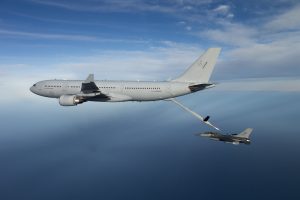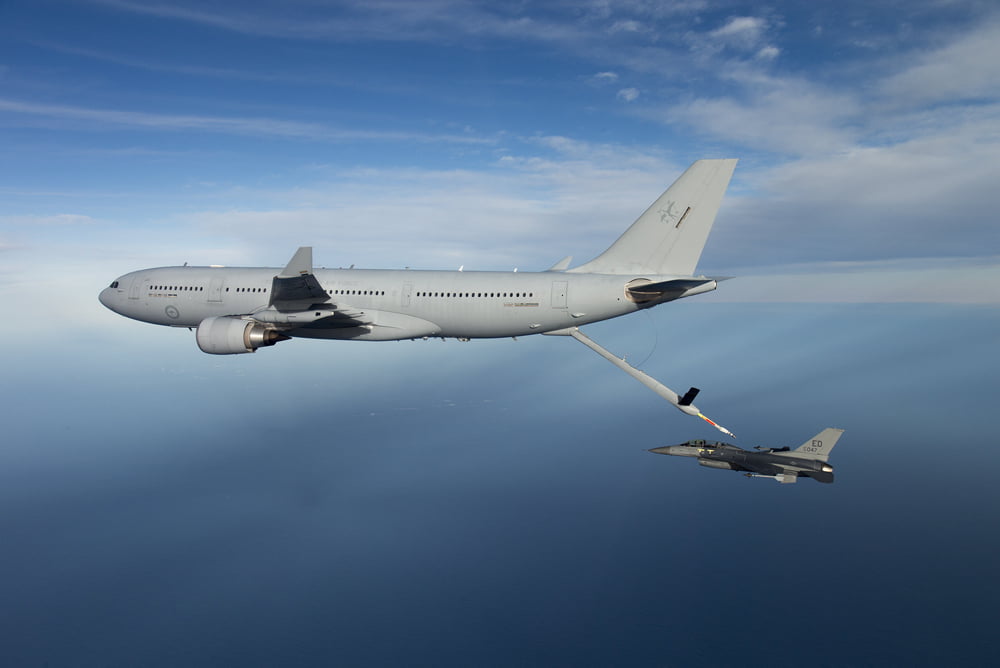2016-08-19 During the Pitch Black 2016 exercise, a KC-30A refueled US F-16s coming from Japan to the exercise in Australia.
On July 19, a RAAF KC-30A flew non-stop with six F-16Cs from Kadena Air Base, Japan to RAAF Base Darwin in just over six hours.
RAAF Group Captain (GPCAPT) Adam Williams, Officer Commanding of No. 86 Wing, said it was the first time that a RAAF air-to-air refuelling tanker deployed in support of U.S. Air Force fighter aircraft to Australia.
“The KC-30A conducted 35 contacts with the six F-16Cs, transferring a total of 55.8 tonnes of fuel to the F-16Cs, or nearly 70,000 litres,” GPCAPT Williams said. “The air-to-air refuelling boom on the KC-30A performed well, with no significant issues.”
https://sldinfo.com/kc-30a-refuels-usaf-f-16s-during-pitch-black-2016/
Now that demonstrated capability has been provided in Middle Eastern operations.
The F-16 is the first aircraft to be refueled in theater with the KC-30A boom.
According to the Australian Ministry of Defence:
An Air Task Group KC-30A has, for the first time, successfully refuelled two F-16C aircraft extending support to the US-led multi-national coalition in the fight against Daesh.
The Air Task Group (ATG) of Operation OKRA is operating at the request of the Iraqi Government within a US-led international coalition assembled to disrupt and degrade Daesh operations in the Middle East Region (MER).
The ATG comprises six RAAF F/A-18A Hornet fighter aircraft, an E-7A Wedgetail airborne command and control aircraft, and a KC-30A Multi-Role Tanker Transport air-to-air refuelling aircraft.
KC-30A Refueling F-16s in Operation Okra from SldInfo.com on Vimeo.
Additionally, the ATG has personnel working in the Combined Air and Space Operations Centre, and embedded with the ‘Kingpin’ US tactical Command and Control Unit.
The ATG is directly supported by elements of Operation ACCORDION including the Theatre Communications Group, Air Mobility Task Group, and the Combat Support Unit, whose mission is to provide airbase and aviation operational support to sustain air operations in the MER.
There are up to 350 personnel deployed, at any one time, as part of, or in direct support of the ATG.
Credit: Australian Ministry of Defence
August 19, 2016
As Group Captain Williams has put it with regard to the impact of the C-17 and KC-30A dyad for the Australian Defence Forces:
“As a dyad, it’s an incredible enabler.
“For example, with regard to a ground force you can put the heavy equipment and heavy spares in the C-17, which specializes in outsized, overweight cargo.
“The KC-30, which can put most of the maintainers and ground combat force upstairs, most of their tooling downstairs and grab a couple of the jets on each wing. It gives you a much better way to hit the ground running.”
The dyad in other words provides flexible support to various ways to mix and match an insertion force.

And this kind of task force projection capability is central to the way the ADF is being transformed overall.
“There’s not many missions that we envisage for the land force that don’t involve them having organic mobility when they hit the ground, so definitely C-17’s a must for any trip Army will take on the KC-30.”
And the Group Captain described an example of how the dyad can support change with regard to the case of Australian Antarctic missions.
“The Australian Antarctic Division currently spend nearly a month in the scientific season leapfrogging helicopters towards the Pole to set up forward stores of fuel and food so that the over-land mission can get its way to the Pole to go and do the science.
“With a KC-30 and C-17 dyad, we could airdrop the science team’s support caches in one mission and provide them an extra month of time to do the science mission.
“That sort of enabler is the creative ways that these two aircraft can offer to government.
“We’re thinking about how that pairing can contribute to the ADF and any of the missions we might be doing, as well as any of the missions that government wants as options.”
https://sldinfo.com/visiting-amberley-airbase-australia-an-update-from-the-86th-wing-commander/


